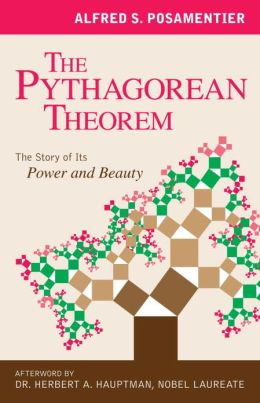Read this article on the Idaho Press Tribune website from Mar. 22, 2012
Read this article on Yahoo! from March 26, 2012
Pythagorean Theorem may be the best-known equation in mathematics. Its origins reach back to the beginnings of civilization, and today every student continues to study it. What most nonmathematicians don’t understand or appreciate is why this simply stated theorem has fascinated countless generations.
 I first met Alfred S. Posamentier in
2001, when he was the Dean of Education at City College in New York.
The energy level of his intellectual engagement with my work is part of
an experience I will never forget.
I first met Alfred S. Posamentier in
2001, when he was the Dean of Education at City College in New York.
The energy level of his intellectual engagement with my work is part of
an experience I will never forget.In his entertaining and informative book, The Pythagorean Theorem: The Story of Its Power and Beauty , Posamentier, a veteran math educator, makes the importance of the Pythagorean theorem delightfully clear.
The Pythagorean theorem has attracted interest outside mathematics as a symbol of mathematical abstruseness, mystique, or intellectual power. Scores of references to it can be found in literature, plays, musicals, songs, stamps and cartoons. It can be introduced to students during the middle school years and becomes increasingly important during high school. It is not enough to merely state the algebraic formula for the Pythagorean Theorem.
According to University of Georgia graduate student Stephanie Morris:
Students need to see the geometric connections as well. The teaching and learning of the Pythagorean Theorem can be enriched and enhanced through the use of dot paper, geoboards, paper folding, and computer technology, as well as many other instructional materials.
The Pythagorean theorem or Pythagoras’ theorem is a relation in Euclidean geometry among the three sides of a right triangle (right-angled triangle). In terms of areas, it states:
In any right triangle, the area of the square whose side is the hypotenuse (the side opposite the right angle) is equal to the sum of the areas of the squares whose sides are the two legs (the two sides that meet at a right angle).
The theorem can be written as an equation relating the lengths of the sides a, b and c, often called the Pythagorean equation: a^2 + b^2 = c^2\!\, where c represents the length of the hypotenuse, and a and b represent the lengths of the other two sides.
The theorem is named after the Greek mathematician Pythagoras, who by tradition (only) is credited with its discovery and proof. The theorem has numerous proofs, possibly the most of any mathematical theorem. These are very diverse, including both geometric proofs and algebraic proofs, with some dating back
thousands of years. The theorem can be generalized in various ways, including higher-dimensional spaces, to spaces that are not Euclidean, to objects that are not right triangles, and indeed, to objects that are not triangles at all, but n-dimensional solids.
Posamentier begins his book with a brief history of Pythagoras and the early use of his theorem by the ancient Egyptians, Babylonians, Indians, and Chinese, who used it intuitively long before Pythagoras’s name was attached to it.
He then shows the many ingenious ways in which the theorem has been proved visually using highly imaginative diagrams. Some of these go back to ancient mathematicians; others are comparatively recent proofs, including one by the twentieth president of the United States, James A. Garfield.
After demonstrating some curious applications of the theorem, Posamentier then explores the Pythagorean triples, pointing out the many hidden surprises of the three numbers that can represent the sides of the right triangle (e.g, 3, 4, 5 and 5, 12, 13). And many will truly amaze the reader.
Next, Posamentier turns to the “Pythagorean means” (the arithmetic, geometric, and harmonic means). By comparing their magnitudes in a variety of ways, he gives the reader a true appreciation for these mathematical concepts.
The final two chapters view the Pythagorean theorem from an artistic point of view–namely, how Pythagoras’s work manifests itself in music and how the Pythagorean theorem can influence fractals.
This lucid presentation and gift for conveying the significance of this key equation to those with little math background will inform, entertain, and inspire the reader, once again demonstrating the power and beauty of mathematics!
No comments:
Post a Comment